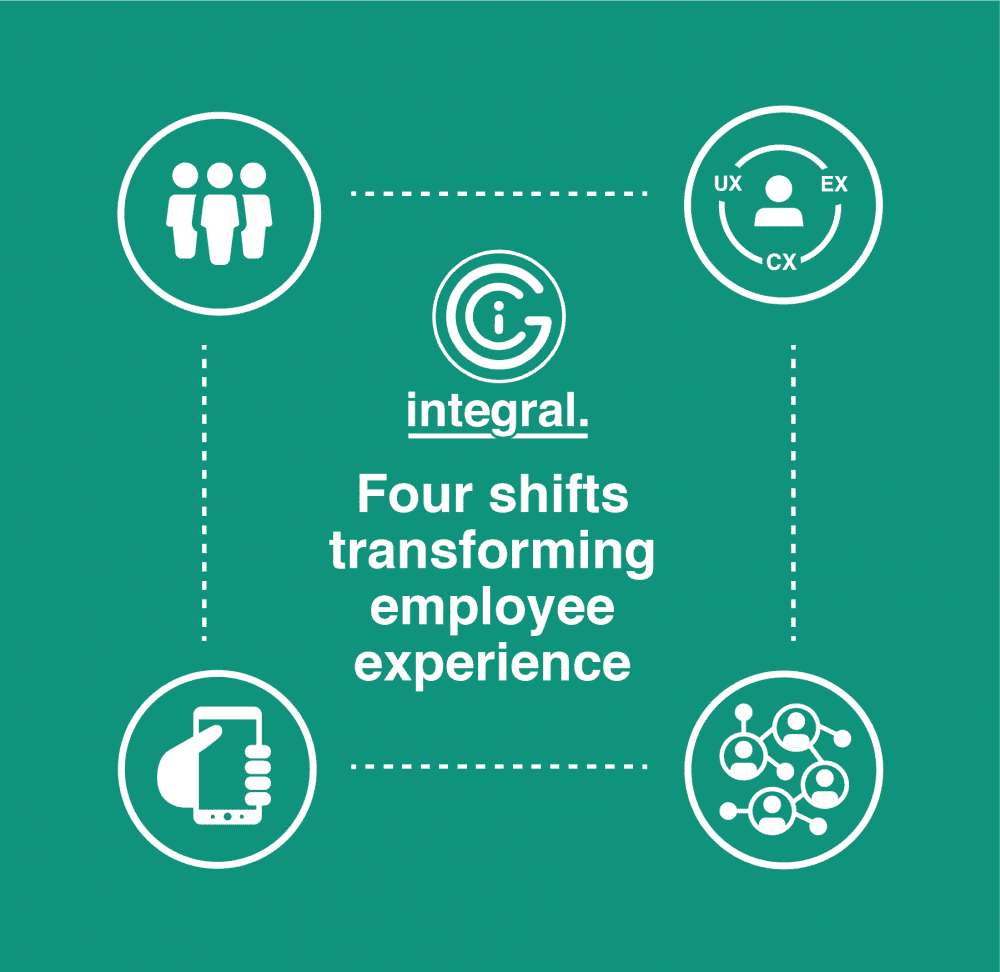
My company, Integral, recently hosted senior Communications, Marketing, and Human Resources leaders at our inaugural Circles event in New York City. Together, we unpacked the ins and outs of designing the kind of employee experiences that deliver business results.
With forward thinkers from Amex, Levi Strauss & Co., Altice, Fitch, Columbia University, Memorial Sloan Kettering, and other great organizations in the room, we all got creative as we reimagined the impact of employee experience teams.
During the event, my team and I shared four shifts we see driving major changes in the way leading organizations must manage the experience employees have every day if we wish to participate in the benefits of financial growth, meaningful work, and societal impact.

Who we serve is shifting…It’s no longer just about the C-Suite
The rise in user-centered-design practices (starting with employees rather than execs!) is not a passing trend, it’s a signal of a new reality where the most coveted workers must be served first.
The historical power inequality between employers and employees is more volatile than ever thanks to digital platforms. The most sought-after segments of the labor market have unprecedented flexibility and mobility, while digital platforms also allow all strata of workers portability of their skills in a way that potentially untethers them from traditional employment. This change has major implications for how we communicate, driving a shift from executive-driven, content & campaigns, with employers at the center to stakeholder-driven experience design, with employees at the center.
What we make is shifting…It’s about experience, not content
The second shift is equally foundational – our focus is changing from creating content, to facilitating experiences. When working with our clients we see again and again a mismatch between intentions and efforts. When we deeply inspect the intentions of the (frequently interdisciplinary) teams entrusted with employee experience we hear an intention to create connections, community, pride – all indicators of engagement. And yet the output of most of these teams is typically content to read or watch. This mismatch suggests to us that the emergent leading practices preserve a capability to produce content – but primarily as an input to an overall experience that may be remembered more for its interactions with other people than its consumption of content.
How we communicate is shifting…The future is a mobile system
How we work is shifting from locally-installed, mobile-friendly-ish, and user-customized tools to cloud-based, mobile-only, and data-personalized systems. We are rarely working within one “program” or “tool” anymore and instead navigating an occasionally-Byzantine, interconnected system of systems sharing functionality and data through APIs and portable identity schemes.
Regardless of your role in the economy, digital systems affect your life, your work, your relationships in increasingly pervasive, intimate, and interconnected ways. Just today a technician came to repair my dryer. Was his first tool a screwdriver? Of course not; he connected to the appliance wirelessly, ran a diagnostic, made some adjustments, and then charged my PayPal account through his iPhone.
How we work is shifting…Collaborate until it’s awkward (then keep going)
Collaboration is the new core competency in employee communications and engagement. The teams responsible for managing the ebb and flow of information and experience between employees and employers are decreasingly centralized departments of specialized skills and increasingly mission-based-teams of multi-position. It’s long been the case that well-run, cross-functional teams can effect a greater measure of impact than siloed departments. But more than ever, we need to partner with other disciplines at deeper levels – the data level, budgetary level, mission and method level. What’s more, the teams who figure out how to navigate those cycles of centralization and decentralization (corporate respiration, as we call it) will enjoy a strategic advantage.
So, what’s it mean for you?
Many of our clients look ahead to 2020 and beyond with an eye to undertake significant work in the areas of EVP development, employee comms platforms/technologies, manager enablement, brand activation, social media advocacy, reorganizations, candidate/new hire programs, and other employee experience touch points. We can approach this important work with an eye to the future by interrogating our plans with the four shifts in mind. Do we really understand the employee mindset? Are we emphasizing content or experience? Have we given due consideration to the landscape of mobile, digital systems? Have we really partnered at the deepest level with adjacent teams to get the work done?
It’s a phenomenal time to work with employees and the communications and experiential touchpoints encountered every day. The winds of change are blowing hard – and there’s no reason they can’t be at our backs.
![]()
 Ethan McCarty is the CEO and Founder of Integral, an employee activation consultancy working with leading organizations on digital transformation, culture as a brand-driver, and employee communications. He spent more than 20 years at IBM and Bloomberg LP as a communications and marketing executive. He is a lecturer on Digital Media & Analytics and Employee Engagement for Columbia University’s master’s degree in strategic communications. @ethanmccc
Ethan McCarty is the CEO and Founder of Integral, an employee activation consultancy working with leading organizations on digital transformation, culture as a brand-driver, and employee communications. He spent more than 20 years at IBM and Bloomberg LP as a communications and marketing executive. He is a lecturer on Digital Media & Analytics and Employee Engagement for Columbia University’s master’s degree in strategic communications. @ethanmccc



